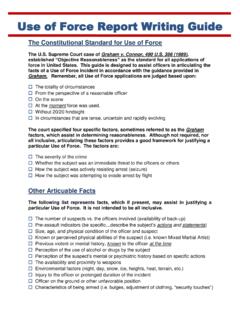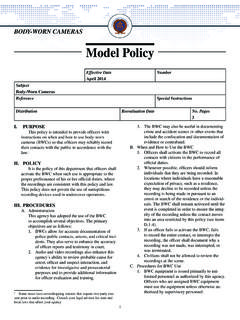Transcription of Ballistic Vest Legal Issues - AELE
1 AELE Home Page Publications Menu Seminar Information Cite as: 2010 (5) AELE Mo. L. J. 201. ISSN 1935-0007. Employment Law Section - May 2010. Ballistic Vests Various Legal Issues Contents Introduction Is there a duty to bargain over mandatory wearing? Is management required to furnish vests at no cost to officers? Product liability Issues Government control of the sale or possession of body armor Summary of Legal points References and notes Introduction Military combatants and peacekeeping officers have worn armor to protect against missiles and edged weapons, dating from the early Greek and Roman periods. Rigid flak jackets were issued to military personnel during World War II. Kevlar was invented in 1966, but soft body armor was not commercially available until 1975, when the National Institute of Justice provided 5,000 vests to fifteen urban police departments as part of a national field-testing program.
2 By March 2006, the IACP/DuPont Kevlar Survivors' Club inducted the 3,000th law enforcement officer who avoided death or serious injury wearing a Kevlar vest. Several Legal Issues have arisen relating to soft body armor. First, in jurisdictions with mandatory bargaining, can management require officers to wear vests without negotiating with the applicable bargaining units? 201. Second, is soft body armor necessary safety equipment that must be provided by the employer at no cost, even if officers are not required to wear it? Third, what parties are liable if body armor is defective? Fourth, can states lawfully license or restrict the purchase and possession of body armor? Is there a duty to bargain over mandatory wearing? Ossining is a town 30 miles north of New York City, where the famous Sing Sing state prison is located. The town's only detective objected to the wearing of body armor when in uniform.
3 He filed a grievance. An arbitrator sustained the wearing of body armor when in uniform, writing that: .. body armor or bulletproof vests come under the category of equipment, and .. is within the Department's sole discretion.. The fact that the chief, a lieutenant and staff officers at headquarters were exempt was not discriminatory. Town of Ossining and Ossining Police Assn., NY-PERB Case #A99-195, 114 LA (BNA) 1761 (Henner, 2000). Similarly, an Iowa arbitrator upheld a policy directing uniformed police personnel to wear protective vests at all times while on duty (with certain exceptions). City of Fort Dodge and UFCW L-P31, Grievance #84-GA-55, 82 LA (BNA) 581 (Roberts, 1984). However, a federal appeals court upheld a Federal Labor Relations Authority ruling requiring management to bargain with a union, before adopting a new policy that body 202.
4 Armor must be worn under an officer's shirt. At the time, Border Patrol officers were given the option to wear or not wear body armor and could wear a vest over their shirts. But in 1988, , management unilaterally required officers to wear body armor under their uniformed shirts. The union filed an unfair labor practice charge when management refused to bargain over the new work rule. The FLRA upheld the charge, finding that management must negotiate the change. A three-judge appellate court affirmed, 3-to-0. They rejected the view that the rule related to an internal security practice and therefore was an exclusive managerial prerogative. They distinguished v. , 855 1454 (9th Cir. 1988), which allowed management to prohibit the wearing of union buttons on Border Patrol uniforms. The union had proposed that officers be allowed to wear the armor over their shirts, but to remain concealed under their jackets.
5 Because of the high temperatures at Mexican border assignments, the change affected their terms or conditions of employment. v. , 12 882 (9th Cir. 1993). Is management required to furnish vests at no cost to officers? Is a ballistics vest (a) equipment (b) a safety device, (c) a uniform component, or (d) all of these? The New Jersey Public Employment Relations Commission ruled that the issue of whether armored vests should be contained in patrol cars was a mandatory subject of bargaining. Twp. of South Brunswick and L-166, Docket No. SN-86-24, NO. 86-115, 1986 NJPER (LRP) Lexis 90. Oddly, there is no known litigation over whether management must furnish Ballistic vests to officers at no employee cost. However, there is a reported case that holds that a firearm is necessary safety equipment of a police officer. In California, an agency must furnish a firearm to police officers at the employer's expense, under a state labor code section requiring employers to furnish necessary safety equipment.
6 Section 6401 of the California Labor Code read: 203. Every employer shall furnish and use safety devices and safeguards, and shall adopt and use practices, means, methods, operations, and processes, which are reasonably adequate to render such employment and place of employment safe. Every employer shall do every other thing reasonably necessary to protect the life and safety of employees.. The appellate court said that the term safety device must be given a broad interpretation so as to include any practicable method of mitigating or preventing a specific danger. Others states have similar laws to protect workers. Oakland Police Officers Assn. v. City of Oakland, #30248, 30 96, 1973 Lexis 1140, 106 134. (1st Dist. 1973). Body armor is Personal Protective Equipment within the context of Washington State Department of Labor and Industries standard WAC 296-24-07501, and must be furnished to peace officers by the employer.
7 [1]. Product liability Issues Dupont's Kevlar is a para-aramid synthetic fiber; Toyobo's Zylon is a thermoset liquid crystalline polyoxazole a synthetic polymer material. Zylon vests were popular due to their lighter weight. Kevlar is also used to make rugged automobile tires; Zylon is used in tennis rackets and medical applications. Ballistic vests constructed with Zylon became controversial in 2003 when an Oceanside, California, officer was killed and a Forest Hills, Pennsylvania, officer was seriously injured while wearing Zylon vests. Zylon vests were recalled and replaced. The Justice Dept. and others filed suit. The primary distributor filed bankruptcy in 2004. Under a 2005 settlement, Toyobo Corp. created a $29 million settlement fund to defray the cost of replacement vests. [2]. Additionally, an injured officer or the next of kin of a deceased officer can file suit and recover against a manufacturer and distributor of a defective safety product, even if the vest or other item is purchased by the employer and furnished to an employee.
8 [3]. However, in most states Workers' Compensation is the sole and exclusive remedy against a negligent employer, superior or coworker. [4]. 204. Government control of the sale or possession of body armor There are several ways to penalize criminals who wear body armor. One is to prohibit the sale of body armor to convicted violent felons. Another is to punish the possession or ownership of body armor by convicted violent felons. The third is to lengthen the imprisonment of a person who commits a felony while wearing body armor, even if he has never been convicted of a violent felony. Federal law prohibits the purchase, ownership, or possession of body armor by violent felons. [5] California has a similar ban, currently under litigation. [6] California also adds one to five years to the sentence of persons who knowingly and intentionally commit a felony while wearing Ballistic armor.
9 [7]. Summary of Legal points 1. Management has the right to require officers to wear soft body armor while on duty. If officers are covered by a bargaining agreement and have been permitted to wear the armor over a duty shirt, management will probably have to bargain a new requirement to wear the armor under a duty shirt. 2. Although no cases involving soft body armor have been reported, a California decision requires agencies to pay the cost of firearms worn by police officers under a statute (found in most, if not all states) that requires employers to furnish safety equipment. AELE's staff urges officers to insist that agencies provide and pay for Ballistic vests. 3. Manufacturers and distributors have been successfully sued for supplying body armor that was unsafe due to unforeseen deterioration. In addition to replacement costs for law enforcement agencies, officers who are injured or the estates of officers who are killed can maintain wrongful death actions.
10 4. States can lawfully restrict the purchase or punish the possession of body armor, of persons who have committed a violent crime, assuming the laws are carefully worded. Alternatively, they can enhance the penalty for wearing body armor while knowingly committing a felony. 205. References 1. Specimen police body armor policies from agencies in five states. 2. History of Kevlar in life protection. (Manufacturer's website). 3. Wikipedia, Ballistic vest. 4. Selection and Application Guide to Personal Body Armor. NIJ Guide 100 01, NCJ. 189633 (2001). 5. Ballistic Resistance of Body Armor. NIJ Standard , NCJ 223054 (2008). 6. Body Armor: Don't Leave Home Without It. National Law Enforcement and Corrections Technology Center (2008). 7. Final Report: The BJA/PERF Body Armor National Survey (2009). Notes: 1. Body Armor as Personal Protective Equipment, WISHA Directive (2006).









